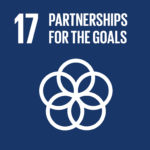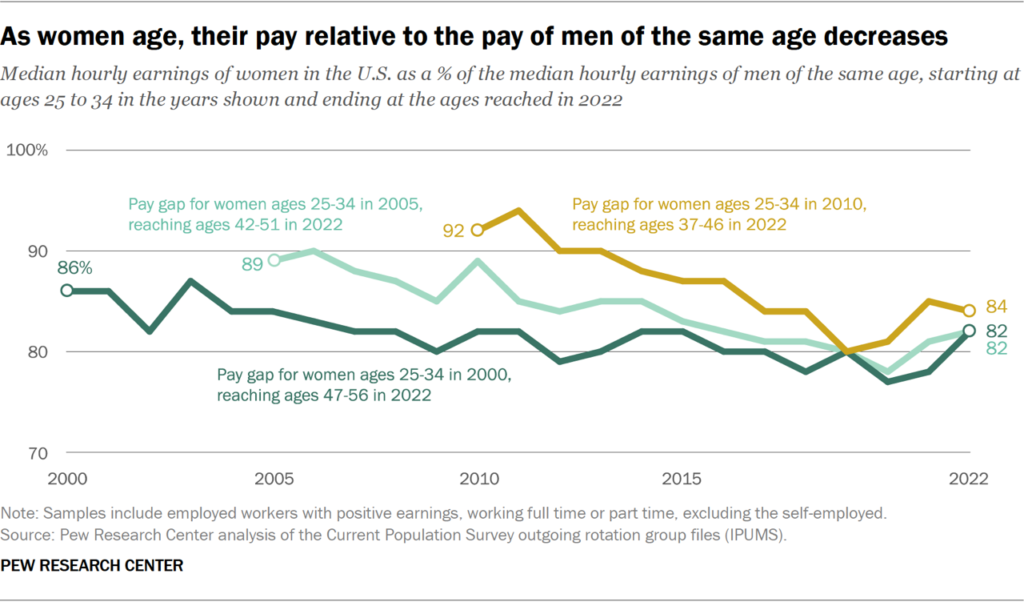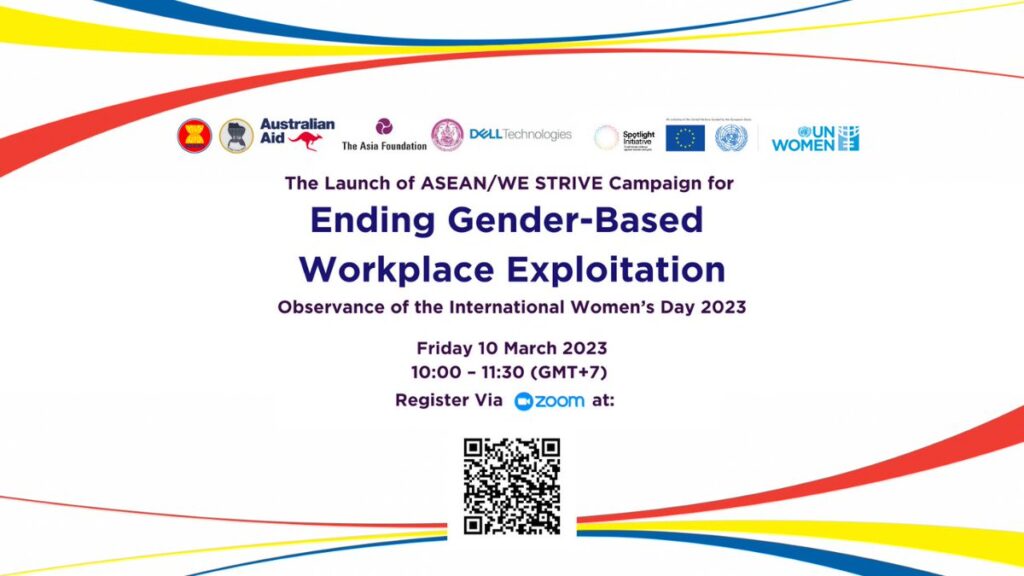Why the cringeworthy flowers and chocolates posts flood my feed? Ah, it’s International Women’s Day. Let’s move beyond the superficial gestures and more about achieving equity for all !
I understand that many organizations celebrate International Women’s Day (IWD) to acknowledge and appreciate the progress made towards gender equality. However, I prefer not to participate in such celebrations because I feel that the one-day celebration oversimplify the issue of gender inequality. One day of celebration does not negate the struggles and injustices that many women still face every day.
RELEVANT SUSTAINABLE GOALS

Stubborn Gender Pay Gap : The Impact of Motherhood and Aging on Women’s Income
You’ve probably heard of the gender pay gap by now, right? It’s a big deal and gets a ton of attention. It’s kind of crazy to think about, but even though we’ve made some progress in closing the gender pay gap over the years, it’s still happening. After shrinking in the 1980s and the 1990s, the gender pay gap hasn’t budged in the 21st Century despite gains in the 20th Century.
At the rate we’re going, it won’t be until 2059 that we finally close this gap. There are a lot of reasons for this, even when you factor in things like education and job experience. It’s a complicated issue, but one that we need to keep talking about if we want to see real change.
Education is not leveling the playing field. The pay gap is just as stubborn for college-educated women as it is for women who don’t have a college degree. Some more bad news, when you become a mother, your pay takes a hit, but the same isn’t true for dads. Having children is a major factor restraining the earning potential of women. But becoming a father actually helps men.
The wage gap for women gets worse as they get older. In 2010, women ages 25 to 34 earned 92% as much as men their age, compared with 83% of women overall. By 2022, this same group of women now ages 37 to 46 earned just 84% as men their age (source : PEW Research). To some extent, the gender wage gap varies by race and ethnicitybecause of differences in education, experience, occupation and other factors that drive the gender wage gap for women overall. But researchers have uncovered new evidence of hiring discriminationagainst various racial and ethnic groups, along with discrimination against other groups, such as LGBTQ and disabled workers. Discrimination in hiring may feed into differences in earnings by shutting out workers from opportunities.
Responsibility for the pay gap lies with those in power — not women, not other marginalised groups, and not the social media execs monitoring these brand accounts. So on IWD and just like every other day: we need to stop using words like ’empower’ and ‘celebrate’. Instead, use words like ‘hire’, ‘promote’, ‘pay’, ‘raise’, ‘bonus’, ‘fund’, ‘invest in’, ‘enrich’, ‘give equity to’, ‘elect’, ‘lead’ – and don’t just say it, DO IT.
Gender-based Violence, Online and IRL , Is Still Here
While societies have made significant progress and advancements, it is still an unfortunate reality that numerous women and girls are subjected to discrimination, violence, and injustice in public spaces, homes, and workplaces. Ironically, several digital technologies reinforce and amplify these biases and stereotypes that exist in the “offline” world, leading to new forms of harm for women and individuals of diverse sexual orientations and gender identities. Moreover, the digital gender gap, which includes digital literacy as well as employment and educational concerns, has added to the existing gender gap.
A persistent gender gap in digital access keeps women from unlocking technology’s full potential. According to recent data, women’s exclusion from the digital world comes with massive costs for all, having already shaved USD 1 trillion from the gross domestic product of low- and middle-income countries in the last decade—a loss that, without an intended plan of action and suitable investment, is expected to increase to USD 1.5 trillion by 2025.
Join us at the launch of the ASEAN/We Strive campaign “Ending Gender-Based Exploitation in the Workplace.” Violence and harassment have no place in the world of work, and this campaign seeks to raise awareness and promote action towards eradicating gender-based exploitation. The launch event promises to be a thought-provoking and inspiring occasion, with speeches from experts in the field, interactive sessions, and opportunities to network with like-minded individuals.
Together, we can create a safe and inclusive working environment for all.
Female Founders Still Aren’t Getting The Equitable Access to Capital
Women entrepreneurs often face barriers when it comes to accessing funding and resources. In 2022, 2% of venture capital funding went to women-only founded startups in the United States, and only 8.6% of the venture capitalists were women. Innovation ecosystems must help bridge this gap by bridging access to funding products and services that fit the profile and needs of women-led ventures, promoting networking opportunities, and resources such as incubators and accelerators that offer mentorship and training.
According to the latest report, The Funding Divide 2022 from DocSend, it appears that even as investors compete for ownership stakes in startup companies, female and minority founders continue to face challenges in securing funding equity. The report revealed that different segments of underrepresented founders, such as women and underrepresented minorities, experienced higher VC engagement and increased funding, but not all groups increased their funding equally. In a record-setting year of dollars allocated into startup funding, with investment totals for 2021 exceeding $600B, the new data shows that not all founding teams are benefiting equally. Worse, all-female team with minority members had 158% more meetings in 2021 than 2020, but raised less money than any other demographics.
According to the State of Women Entrepreneurship in India 2023 report by YourStory and Kalaari Capital’s CXXO initiative, less than 1% of all institutional investments in 2021-22 went to women-led businesses, with nearly 60% of women leaders saying they faced some form of bias in the last year, according to the State of Women Entrepreneurship in India 2023 report.
Venture capital is a man’s game. Women are massively under-represented among both venture-backed entrepreneurs and VC investors, with companies founded solely by women receiving less than 3% of all venture capital investments and women accounting for less than 15% of check-writers. It’s a vicious cycle: If VCs are more comfortable “betting on somebody that looks like them,” it’s hardly surprising that investors — who are majority male — are much more likely to bet on startups led by men.
As with any systemic inequity, what we really need is structural reform of the VC industry. Instead of trying to remedy us female founders with the “12-week programme on getting female-founders’ pitch-perfect and VC investable”, perhaps the industry should remedy itself with the “Fifty Percent Club”: a club where all member firms have a 50% female investment committee. Because the root cause of the problem lies in the structural bias within the VC industry, rather than female founders not meeting the necessary standards.
Growing Burden of Climate, Water and Energy On Women and Girls
While climate change affects everyone, it does not affect everyone equally. Vulnerability to climate change is exacerbated by inequity and marginalization linked to gender, ethnicity, low income, and other social and economic factors.
In countries like Bangladesh and India, women residing in rural areas are heavily involved in household tasks, such as collecting water and firewood for cooking, in addition to their roles as caregivers. Consequently, they carry a disproportionate burden of household work, which impacts their daily routine. Furthermore, women are more susceptible to the effects of climate change than men. For example, in 2007 and 2009, two back-to-back cyclones, namely SIDR and Aila, respectively, wreaked havoc on coastal areas of Bangladesh, which is home to 20 million people.
Due to the increased levels of salinity intrusion, many villages had no access to fresh water. As a result, women from these coastal regions spend more than an hour collecting water from distant sources, which takes a toll on their health. Often, schoolgirls also assist their mothers in collecting water, which disrupts their education. In contrast, men and boys tend to avoid strenuous tasks like gathering water for household use.
When it comes to building climate resilience in communities, involving women is crucial. In fact, the UN reports that communities are more successful in resilience and capacity-building strategies when women are part of the planning process.
Additionally, women are usually first responders in community responses to natural disasters, leaders in disaster risk-reduction, and contribute to post recovery by addressing the early recovery needs of their families and strengthening community building. By involving women in community planning and disaster response efforts, we can build stronger, more resilient communities that are better equipped to face the challenges of climate change.
IWD : Is there A Place For Men?
Let’s break this down a bit. When we talk about women’s empowerment, it’s not just about women themselves. Sure, women play a huge role in empowering themselves and other women, but there are other factors at play. Men and society as a whole have a part to play in creating an environment where women can truly thrive.
Think about it like an ecosystem. Women are the plants, but they need the right soil, sunlight, and water to grow. Men and society are like the gardeners who provide those essential elements. Without them, the plants won’t flourish.
So, when we talk about women’s empowerment, we need to consider the larger context. We need to look at the ways that men and society as a whole can support women’s growth and success. It’s not just about empowering women in isolation; it’s about creating a world where everyone has an equal opportunity to thrive and take actions to fill the gap.#RealEquity comes from behavior. It comes from the action we take, the choices we make, and the voices we amplify. It also comes from what we call out and what we normalize, or not.
You may also be interested in :
The Case of Martha Sabar : Are health Systems Failing Mothers ?






